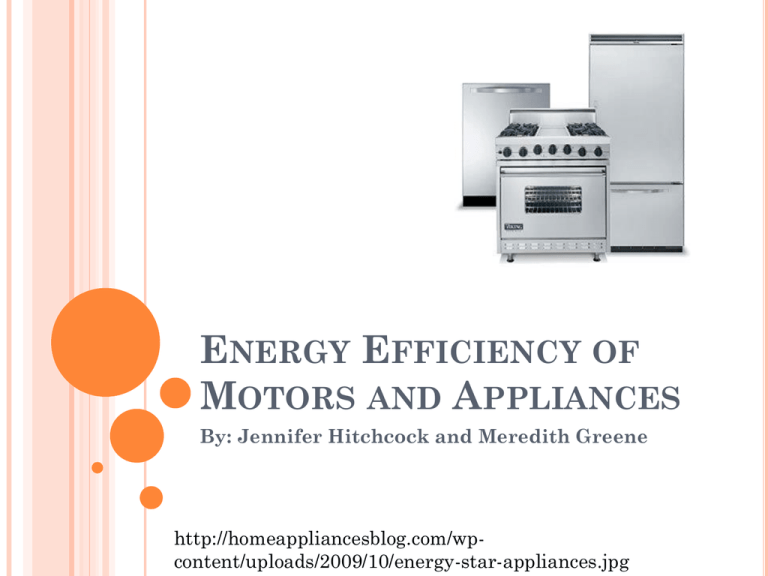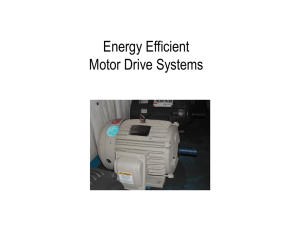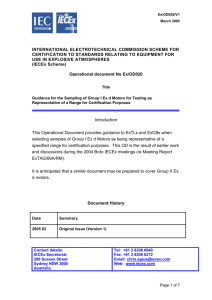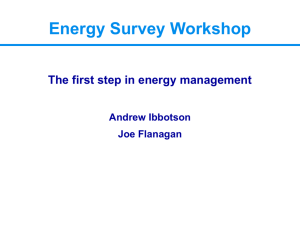Energy Efficiency of Motors and Appliances
advertisement

ENERGY EFFICIENCY OF MOTORS AND APPLIANCES By: Jennifer Hitchcock and Meredith Greene http://homeappliancesblog.com/wpcontent/uploads/2009/10/energy-star-appliances.jpg ENERGY EFFICIENCY PURPOSE The purpose of energy efficient appliances and motors is to be able to supply the same level of energy service only using less energy. Efficient energy use is achieved primarily by means of a more efficient technology or process rather than by changes in individual behavior. Energy conservation reduces the energy consumption and energy demand per capita and thus offsets some of the growth in energy supply needed to keep up with population growth MAKING A DIFFERENCE Along with saving money, energy efficient appliances and motors save the plant The energy used to run a product can be cut up to 80% There is a large potential to make a difference because all appliances energy usage can be cut Fridges, washers, dryers, cars Light bulbs, anything that plugs Into an outlet. http://johnlmclane.com/yahoo_site_ admin/assets/images/EnergyStarLo go_orignal.29062643_std.gif OPERATION You can apply new ways to your old appliances to make them more energy efficient Keep air filters clean, vents clean, and baseboards clean Get a furnace tune up Defrost your refrigerator so ice doesn’t build up on the coils Turn off appliance when they are not being used Un-plug appliances OPERATION http://www.westernconsolidated.com/motors.html http://www.thefuture-energy.com/efficiency.gif http://images.machinedesign.com/images/archive/applia nc0501jpg_00000031821.jpg Motor-driven equipment accounts for 64 percent of the electricity consumed in the U.S. industrial sector. Within the nation's most energy-intensive industries motor systems consume approximately 290 billion kWh per year. http://www.srpnet.com/electric/business/manufacturing.aspx Motor Efficiency: Converting Electricity into Mechanical Motion The energy efficiency of motors depends on the type of motor. Some are built to be more energy efficient while others are not. It may be wise to invest in motors with higher efficiencies than what is required, even if they are a bit more expensive. Energy efficient motors reduce the amount of lost energy going into heat rather than power by using steel with better magnetic qualities, bigger diameter wire, and better bearings. Since less heat is generated, less energy is needed to cool the motor with a fan— further improving energy efficiency. How Much Energy They Consume as Compared to Purchase Price Over a typical ten-year operating life, a motor operating most of the time can easily consume electricity valued at more than 50 times the motor’s initial purchase price. This means that when you spend $1,600 to purchase a motor that operates continually, you may be obligating yourself to spend more than $80,000 on electricity. Another example is that even at the relatively low energy rate of $0.04/kWh, a typical 20horsepower (hp) continuously running motor uses almost $6,000 worth of electricity annually, about six times its initial purchase price. Savings by Use of Efficient Motors Over half of all electrical energy consumed in the United States is used by electric motors. Improving the efficiency of electric motors and the equipment they drive can save energy, reduce operating costs, and improve our nation’s productivity. The potential savings in system improvement opportunities are very large - over 100 billion kwh/year energy savings and $3 billion (U.S.) annual energy cost savings opportunity with existing and new technology by 2010. Saving Con. Annual Value of a One-Point Efficiency Gain (Based on $0.04/kWh, 8000 Hours of Use, Full Load) Horsepower Annual Savings 5 $17 10 $32 20 $61 50 $142 100 $278 200 $537 Savings Con. http://www.efficiency-fromgermany.info/EIE/Navigation/EN/Technologies/industry,did=2 54500.html?view=renderPrint Technological Obstacles There is an impending shortage of many rare raw materials used in the manufacture of hybrid and electric cars. For example, the rare earth element dysprosium is required to make many of the advanced electric motors used in hybrid cars. However, over 95% of the world's rare earth elements are mined in China, and domestic Chinese consumption is expected to consume China's entire supply by 2012. Political/Economic Obstacles Motors must meet certain federal laws for them to be produced. Most general-purpose motors sold after October 1997 must meet the NEMA (National Electrical Manufacturers Association) definition, according to federal law. The following are major design and manufacturing standards covering electric motors: International Electrotechnical Commission: IEC 60034 Rotating Electrical Machines National Electrical Manufacturers Association (USA): NEMA MG 1 Motors and Generators Underwriters Labratories (USA): UL 1004 - Standard for Electric Motors Political/Economic Obstacles Con. On December 19, 2007, President George W. Bush signed into law the Energy Independence and Security Act of 2007. Similar to its predecessors, the Energy Policy Act of 1992, and the Energy Policy Act of 2005, and related pieces of legislation dating back to the 1970s, the 2007 Act aims to restructure and reduce, or at least slow the rate of growth in America’s energy consumption. Perhaps more importantly for motor users the 2007 version increases the mandated efficiency of electric motors in commercial and industrial applications, and expands the range of motors that in question. The 2007 Act takes effect on December 19, 2010. NEMA Premium® will become the minimum efficiency standard for many motors in 2010, making the U.S. standards the highest in the world. http://www.energysmartmotors.org/images/different_motor.gif http://www.energysmartmotors.org/purchasers/images/Motor%20Graphi c%202.jpg Negative Environmental Impacts Appliances have to get energy from somewhere, and the energy comes from power plants. These power plants are one main source of air and water pollution. They also release radioactive materials into the atmosphere. Used appliances also produce electronic waste, which are discarded, surplus, obsolete, or broken electrical or electronic devices. The processing of electronic waste in developing countries causes serious health and pollution problems because electronic equipment contains some very serious contaminants such as lead, cadmium, beryllium, mercury, and brominated flame retardants. Even in developed countries recycling and disposal of ewaste involves significant risk to workers and communities and great care must be taken to avoid unsafe exposure in recycling operations and leaching of material such as heavy metals from landfills and incinerator ashes. Phantom Loads The phantom load is the electricity consumed by a device when it is turned off. For example, your television consumes electricity as it waits for you to hit the “on” button on your remote. Your clock uses up energy 24/7 to keep track of time. Devices that have a phantom load are sometimes called “vampires.” These devices have a hidden energy cost that most people are never even aware of. Nationally, phantom loads make up about six percent of our energy consumption. This translates into billions of dollars spent and countless amounts of pollution emitted into our air. How to Deal with Phantom Loads Unplug all devices when not in use. Alternatively, plug your devices into a power strip and turn the strip off when you go to sleep. Be careful when using cube shaped transformers that plug into the wall. They are 60-80% inefficient when plugged in, so it is especially important that these are on power strips. http://www.howstuffworks.com/insidetransformer.htm/printable Improvements Increasing the thickness of the copper wires wound around the core of the motor. This reduces both the electrical resistance losses in the wires and the temperature at which the motor operates. Using more and thinner high-quality steel sheets for the main fixed and rotating parts of the motor. This also minimizes electrical losses. Narrowing the air gap between the spinning and stationary motor components, increasing the strength of its magnetic field. This lets the motor deliver the same output using less power.











